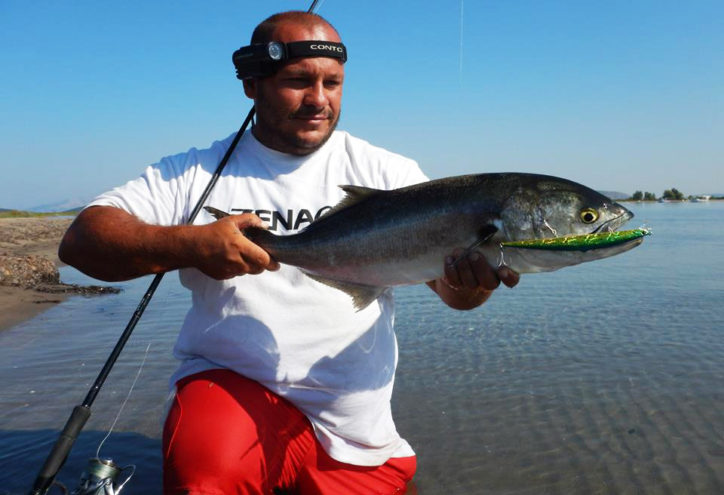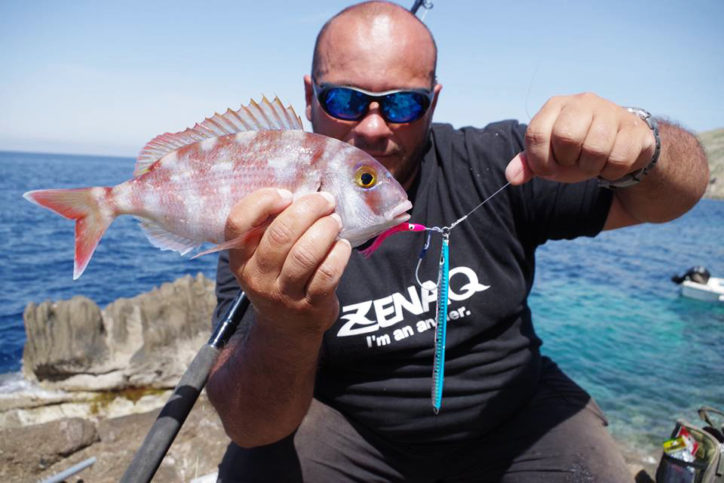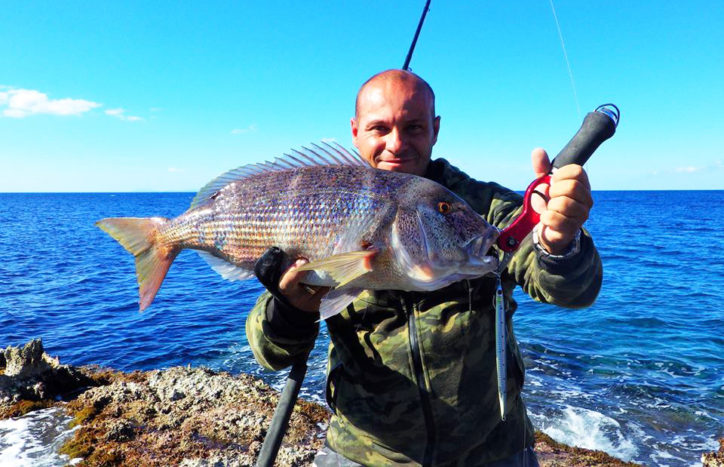Markos Vidalis is one of the most famous anglers using spinning rods in Europe, actively promoting sea spinning fishing and shore jigging.
Markos manages to catch excellent fish both from the shore and from the boat, keep his website, in which he shares his observations and knowledge, shoot and upload videos on his YouTube channel, test rods, reels, braids and lures produced by various manufacturers, as well as control the quality of the texts of articles (he is the editor-in-chief of two Greek fishing magazines).
adriaticnature decided to talk to Markos Vidalis about the tackles and thoughts fishermen should have, while seeking the trophies on the shore; what should be done next; what fish species, where and when should be searched for; how one can start understanding the sea.

(Markos with a goldblotch grouper caught on a heavy soft lure. Foto © Markos Vidalis)
Hello, Markos! Thanks for getting round to having a conversation on the adriaticnature pages. At the beginning of our talk, I’d like to say thank you so much for promoting sea shore fishing; you played a crucial part in making it so popular nowadays. I have a question: is shore jigging the best way to catch predatory fish on the sea from the shore?
Hello. The answer to your first question is no. Spinning and lure fishing, in general with minnows, top water and soft lures, is the easiest way to catch predatory fish. But shore jigging has a great advantage. It can be used at great depth and under the conditions, when other lures fail, for example, in high winds and in deep places.

(Markos with a common dentex caught on a metal jig. Foto © Markos Vidalis)
Do you clearly understand, which fish you are going to try to catch, when you go for a trophy and prepare your spinning rods? Or, maybe it all happens the other way round. Perhaps, you take several sets of spinning rods, various types of lures and figure out the situation on site, don’t you?
This is a “two answers” question. Ok. When I go to a certain place and have a specific target, then yes, I have my gear already set for that. For example, when I go to the river mouth targeting leerfish, I have one rod and reel and several lures for that fish. Of course, same lures can also be effective with bluefish and seabass that occur in the same territory. The same happens on the rocks. If I’m on a deep rocky shore, then I have one strong set with adequate lures to cover all circumstances. But when I go on a fishing trip to a place that I plan to search and I’m not sure about fishing activity and where to look, then yes, I might take up to 4 sets with me.

(Markos with a bluefish caught on a minnow. Foto © Markos Vidalis)
Let’s talk a little about shore jigging. All of us adore it, so we have to ask a few questions about it. Can you recommend a basic set of jigs for fishing on the Mediterranean Sea? For example, a person goes on vacation. He doesn’t have the opportunity to take a lot of them, and then he doesn’t have enough time to try them all. Little tunny, bonito, leerfish, amberjack, grouper, dentex, there are so many fishes! Nobody wants to throw money away and still everyone wants to have a chance to catch a trophy. What should be brought or bought on site?
I will answer you what I do. My shore jigging bag weighs more than 12kg and I carry it all over. Why? Because jigs are like lures. Sometimes they don’t like blue and like pink or yellow. Other times they don’t like slim and they like short ones. And you must keep in mind the fact that jigs are easy to lose. So you must have at least two of your favorite ones.

(Markos with a red porgy caught on a metal jig. Foto © Markos Vidalis)
As for specific jigs, it’s hard to suggest and it would be irresponsible, because completely different jig preferences occur depending on the place and season. Right now I’m developing an amazing jig with Savage Gear and it will be available soon. I believe that it will cover most species and places. Here’s a general advice: take as much tackle as possible and keep changing and trying, like you do in case of spinning fishing.
Do we really need plugs, poppers, walkers and other plastic lures when searching for trophy fish? Can we abandon them and devote all the time only to jigs? And if they are needed, surely there are plastic lures in your box. What are they, if you don’t mind my asking?
When I go shore jigging, I spend most of my time using jigs. But if nothing happens, I always try poppers, silicone lures and sinking pencils. Some of them are Savage Gear saltwater sandeel preferably at 65 & 100gr, DUO malice, DUO Saira, Savage Gear surf walker mag size, Savage Gear panic prey 195 and Savage Gear jerk minnow 210.

(Markos with a leerfish caught on a minnow. Foto © Markos Vidalis)
Tell me, please, how to find the right moment to put aside the spinning rod for shore jigging, and switch over to plastic and soft plastic lures or vice versa?
There is no magic moment. It is perception. You do it when you feel it mostly. But of course if you see mahi mahi mahi or leerfish active on the surface, then you must change from a jig to a top water lure for sure.
Of course, it’s clear that fishermen should be aware of the seasons and the activity of predatory fish. However, it turns out that many fishermen, due to different circumstances, go to the seaside at the time they have such an opportunity. So what should they do? Tell us, please, about the tactics of searching for fish. Where should it be done? What should a fisherman pay attention to, when he comes to a certain site for the first time? How to start the search for predatory fish on the sea shore?
This is another problem that anglers have to deal with. As for me, fishing is my job, therefore, I choose carefully the days to go. There are many factors that make a day ideal or terrible. The phase of the moon, the wind direction, the tides and the light conditions. All these things play a great role. The problem is that these factors are not the same for every place.

(Markos with a yellowmouth barracuda caught on a minnow. Foto © Markos Vidalis)
For example, in my country, west wind is extremely bad for the Saronic sea and anglers call it “the wind scaring fish”. But west wind in Ionian sea is very effective. Same with the moon. Full moon for bluefish, for example, in Nafplion is pointless. Full moon in Halkida is super. So it is easy to understand that if we do not keep notes of each fishing and we go randomly, then it is like a lottery and we will never discover why some days were great and others weren’t. Season determines the species of fish. For example, here mahi mahi appears in late summer and leave in early winter, so it is very hard to find them in spring. All the above show us that if we want to evolve, the worst thing is to mimic and ask a lot of other anglers. Only you can make yourself better by experimenting, keeping notes and going fishing as often as possible. The PC has never brought a single fish at your doorstep.

(Markos with a common dentex caught on a metal jig. Foto © Markos Vidalis)
Now about searching, if you go fishing “blindfolded”, then a wide range of lures of different types and a lot of experimenting from the surface to the bottom will pay off eventually.
I really want to ask you about the fish species that can and should be caught from the shore, and the tactics of searching and catching them. Let’s start with pelagic fishes, such as little tunny and bonito, if you don’t mind. Where should they be searched for and what should be done?
This is a very hard question. Even the whole book won’t be enough to answer it, so I will try to give a much summarized answer. Always remember that sometimes completely different rules are relevant, depending on the season and spot. For example, bonitos love very small baitfish in spring but larger baits in fall. Differences in behavior like this appear to all the below mentioned species on different matters according to the season. So here is the best I can do.
Little tunny and bonito?
They like deep waters or shallow waters that always border with deeper waters, full of oxygen and small baitfish. They don’t like the mix of fresh and salt water. They like fast movement of the lures and jigs in general. They like rocky shores and they are active with severe weather conditions all day long, and with calm sea mostly at dawn and dusk. They strike from mid waters until the surface. Jigs and minnows are ideal!
(Catching of little tunny (false albacore). Video © Markos Vidalis)
Dentex?
They like deeper rocky waters and calm sea in general. They also like medium size bait and sometimes big ones. They hate the mix of fresh and saltwater. They are very active when the sun is very high and bright. They don’t like very fast action of the lure and jig. This strike zone of this fish is always near the bottom. Jigs, heavy soft lures and heavy minnows are ideal!
(Catching of common dentex. Video © Markos Vidalis)
Groupers?
Like Dentex, goupers have the same features in general, but they are more active during early hours and late ones. Also they love big bait. Jigs, heavy soft lures and heavy minnows are ideal!
(Catching of goldblotch groupers. Video © Markos Vidalis)
Leerfish and bluefish?
These fish like mixed freshwater and saltwater. River mouths and sandy beaches are ideal places to look them up. They also like big baits and can be active to both high and medium speed lures. They are aggressive mostly on surface. They can be active all day, but bluefish is active at night, while Leerfish isn’t. Topwaters and minnows are ideal lures.
(Catching of leerfish. Video © Markos Vidalis)
Amberjack?
They like deeper waters with oxygen, and they are very aggressive about high speed lures. They are active all day, but more aggressive at dusk and dawn. Their strike zone is from the bottom to the surface! Jigs and heavy minnows with fast animation is the key for a strike.
(Catching of greater amberjack. Video © Markos Vidalis)
Seabass?
I can’t say many things about this fish, since it is a “chameleon” in its character. You can find it in ports on a quiet night, on sandy beaches with waves and muddy waters during day, on rocky beaches during calm sunny weather. And you can catch it with top water lures, soft lures and minnows. This fish requires using a certain fishing technique called the seabass fishing and it’s almost “science”.
(Catching of European seabass. Video © Markos Vidalis)
You usually get to your “shore” sites by boat. You have a boat, but you go ashore and fish from the shore! Is this “dedication”? Is shore fishing more efficient? Or maybe it’s just your favorite kind of fishing, isn’t it?
Actually, I mostly walk. I don’t know how you came up with this conclusion. I use boat to get to new places only when the sea is very calm, but without a doubt severe weather means better shore jigging conditions. In case of severe weather, it is impossible to get even close to the sharp rocks by boat, unless you have a death wish.
(Catching of leerfish, bluefishes and European seabass. Video © Markos Vidalis)
In case of spinning fishing on river mouths, I like to use the boat. But as for shore jigging and in general shore fishing, as you said, it is a dedication and for me a big fish coming from the rocks is worth more than 10 fish coming from a boat.
What can you say about the color of lures for catching sea predators? Is it really important?
Lure color is critical and it has been proved thousands of times. Like in freshwater. How many times fish were reluctant to strike one color and attacked another color of the exact same lure model? Sometimes you just change the color and the party begins.
You rarely show lure retrieving in your videos. Is this your secret?
This is a very “narrow” way of thinking. Probably you should consider how much time I spend on fishing and if there is a camera with such a recording battery capacity. NO! This is why I moved to a camera with replaceable battery and since last November ALL of my videos contain not only live strikes, but lessons for using jigs and lures and so on. And it will stay this way. So how can you say “I rarely show lure retrieving”?
(“Lift that fish!!!”. Video © Markos Vidalis)
Summing up, there are no secrets in sea fishing. It is simply observation and understanding. It is a whole system with rules and laws that can be easily understood, when we simply focus on this and spend time, and don’t try to discover someone else’s “secret”. This will only push us many steps back!
Keep fishing, guys!